The rise and fall of Maradona
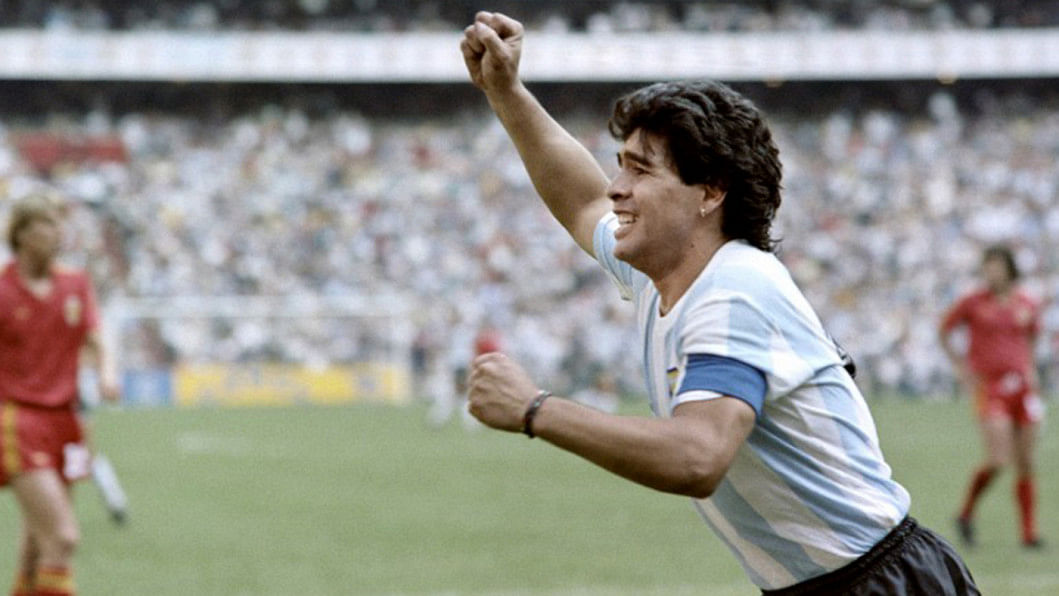
Humble beginning…
One of the greatest football players, if not the ‘greatest’, Maradona, Diego Armando Maradona was born in Villa Fioriotio, Argentina on October 30, 1961.
In his childhood dreams, Maradona saw himself as a great football player, even as he faced the harsh realities of living in the slums of Villa Fiorito outside Buenos Aires.
Maradona’s family was unfortunately poor. His father, a bricklayer and factory worker, struggled to provide for three boys, five girls, and his stay-at-home wife, according to encyclopedia.com
Poverty, however did not snatch away the dreams of a young boy destined to experience unprecedented glory and greatness.
Maradona was given his first football by his cousin, Beto Zarate, on his third birthday.
He would practice dribbling and other skills with the ball as long as he could stand.
Young Diego slept with the ball at night. By the age of nine, he had learned to play football, and came to the attention of Francis Cornejo, coach of the Cebollitas or Little Onions—the youth team of Argentinos Jrs.
While he was with the Little Onions, they won 140 straight games. In 1972, he led Los Cebollitas to a junior championship.
The team gave him the best compliment— jersey number 10—the same number worn by the legendary soccer star, Pele.
From 1976 to 1980, the teenage Maradona played for Argentinos Juniors. Before the end of the first season, the team became Maradona's team, and the stadiums were always full of people cheering and rooting for the star on show.
The Argentinos Juniors were winning against the best teams, and Maradona’s future looked boundless.
However, his first major disappointment came early when he was left out from Argentina's 1978 World Cup championship team by coach Cesar Menotti.
In 1982, Maradona got his chance to play in the World Cup, but was far below his best, got himself ejected in the match against Brazil by kicking a player in the groin.
Junior World Cup Championship
Maradona became a national sports star playing for Argentina's Boca Juniors at the age of 16.
He was the youngest player ever to join the national team. In 1979, Maradona was named South American Player of the Year after he led Argentina to the Junior World Cup.
The Big Move to Barcelona
His name made international headlines again in 1982 when he was sold to Barcelona, in the Spanish League, for the then unheard of $7.7 million. He was only 21 years old.
At Barca, Maradona couldn’t settle down well due to his injuries, the role his coach wanted him to play and of course, the ills of fame and fortune. At Spain, Maradona’s deadly relation with cocaine and other drugs began in earnest.
Yet when it came to football, Maradona did not disappoint his team and supporters when fully fit, and is still remembered today for a spectacular goal against Real Madrid at the Santiago Bernabeu.
On June 26 1983, Maradona became the first Barcelona player to be applauded by arch rival Real Madrid fans for his superb solo goal in the El Clasico.
Though the Spanish found Maradona's ego abrasive, they forgave him when Barcelona won Spain's championship.
During his two injury-hit seasons at Barcelona, Maradona scored 38 goals in 58 games.
Maradona arrives at Napoli
In 1984, he was sold to Naples, in the Italian League, for a record $12 million.
Fans in Naples called him "San Diego." While his name became well known after his World Cup win for Argentina, Maradona soon proved his value to Naples as well.
1986 World Cup at Mexico
At the age of 25, Diego Maradona was the central figure of the 1986 World Cup challenge.
The short, stocky midfielder scored two goals against the English to knock them out of the competition.
The first was cause for great debate, as he had hit the ball with his hand, an illegal move. Maradona had shrugged it off, saying, "from the hand of God to the head of Maradona."
He apologized four years later on Italian television as reported in the Chicago Tribune, "It was my hand, not His. I don't want anyone to think God robbed someone, rather it was Maradona who did the robbing."
The second goal, however, guaranteed him a place in football history.
Having controlled the ball for over half the field, guarding it from the English midfield and defense, he slid the ball off his left leg into the net, faking out goal tender Peter Shilton.
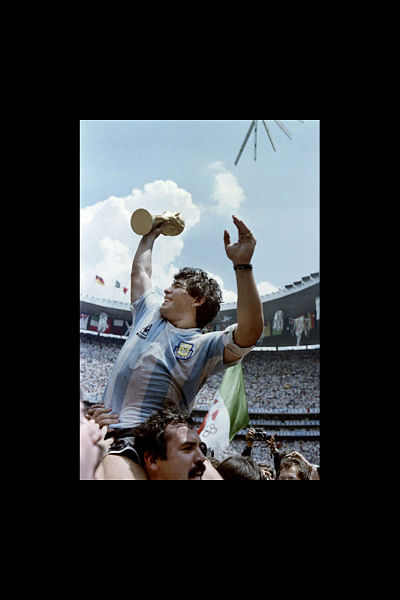
Argentina's coach, Carlos Bilardo, told the press, "It is the second time in my life I have celebrated a goal with a scream. It was spectacular."
The 1986 World Cup was a triumph for Argentina and made Maradona the most famous soccer player since Pele.
He was even named "athlete of the decade" by the British. His career would have many more highs and lows in the years to come.
As Phil Hersh wrote in 1990 in the Chicago Tribune, "One thing is sure: The goal against England still counted, and so did everything that followed, including uncounted riches, two paternity suits (one dismissed, one still pending), a second apotheosis, two children out of wedlock with his future bride, allegations of involvement with the Neapolitan mob, a wedding feast of wretched excess, and selection as athlete of the decade by the British, whom he quite possibly had cheated out of the World Cup title."
Maradona making headlines at Napoli
Back in Italy in 1987, Maradona helped the previously 12th-placed Naples team to win the Italian League crown.
Maradona was the top scorer in Serie A in 1987/88, and is the all-time leading goalscorer for Napoli with 115 goals.
When asked who was the toughest player he ever faced, A.C. Milan legend Franco Baresi stated: "Maradona; when he was on form, there was almost no way of stopping him", a view shared by his Milan teammate and fellow all-time great Paolo Maldini, who stated: "The best ever I played against was Maradona."
Napoli won the Serie A again in 1990. These were the first two league titles to be won by the Naples team since it was founded in 1926. He also led Naples to victory in the European Soccer Union Cup competition in 1989.
Off the field, Maradona's behavior spiced up the headlines.
Throughout June 1989, there were rumors that he would be sold to Marseille in the French League for over $15 million.
While Maradona denied the rumors to the press, soccer fans in Naples reacted negatively. He responded by calling them cretins.
In August, Maradona failed to attend training camp, claiming that the Neapolitan Mafia was threatening him and his family.
He was fined for missing nearly a month of training. In October, an argument with a referee during the Rome-Naples match cost him $7,000.
In 1989, Maradona married Claudia Villafane, his childhood sweetheart and the mother of his two daughters.
The wedding was a major event, costing around $3 million. There were 1,200 guests in attendance at the Buenos Aires nuptials.
An 80-piece tango orchestra entertained the crowd. The bride and groom rode in a Rolls-Royce Phantom III, rumored to have been owned by Nazi Joseph Goebbels.
Ninety-nine gold rings were hidden in the wedding cake.
The Unraveling of a Hero and Villain
In June 1990, Maradona represented Argentina in World Cup competition. He played badly in the semi-finals, missing penalty kicks he should not have missed.
Despite Maradona's poor performance, Argentina was still able to claim a victory, winning 3-2 over Yugoslavia.
Argentina lost in the finals to Germany in a game where Maradona’s performance was not poor, but the lack of finishing skills by the strikers cost his team dearly.
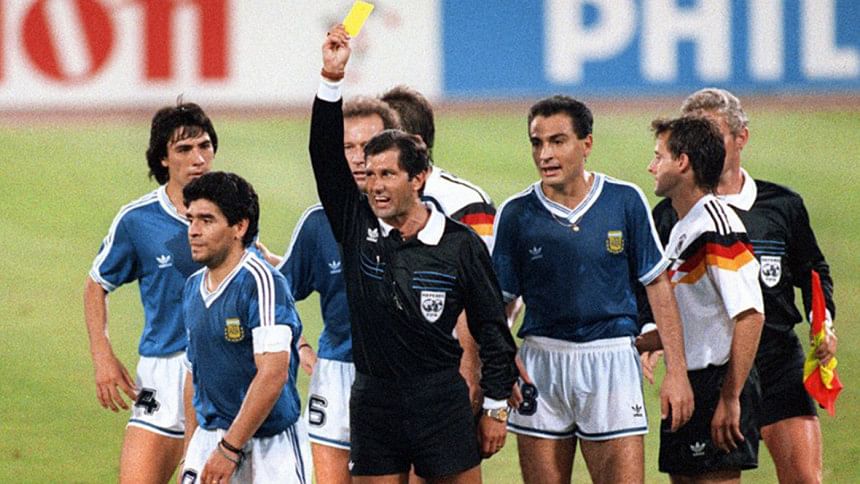
The following year, Maradona's personal life began to affect his game. He gained weight and argued with officials.
In 1991, he was banned from soccer following a March 17th test showed traces of cocaine.
Maradona voluntarily started a drug treatment program after his suspension. When faced with a $35,000 fee for the service, he balked.
On July 8, 1992, he was quoted in the Dallas Morning News: "They're ripping me off just because I'm Maradona."
In 1992, the San Diego Sockers of the indoor Major Soccer League courted Maradona.
However, he was not allowed to play unless the Sockers purchased his contract (valid through 1993) from Naples.
A further obstacle was that Maradona had announced that he would be retiring from soccer. The talks never came to fruition.
Maradona's 15-month suspension for drug possession ended on July 1, 1992.
He had decided not to return to Naples to honor the last year of his contract. He emerged from the ordeal 20 pounds overweight, with charges of cocaine possession in Argentina and a paternity suit in Italy.
An Italian court ruled that Maradona had to support Cristina Sinagra and her then six-year-old son, Diego Armando.
Maradona was released from his contract with Naples by the International Soccer Federation. "He is a player who has finished his suspension," a Federation director told the press.
"He's rehabilitated to play professional soccer. We don't have anything against him. On the contrary, we're very happy" ( Dallas Morning News, July 1992).
Maradona tried to rebound in 1992, signing a deal with Seville in the Spanish League.
The association was short-lived due to disagreements between Maradona and the club's management, which included manager Carlos Bilardo, who had led the Argentines to the World Cup championships of 1986 and 1990.
Maradona was expelled from Seville on June 29, 1993 and returned to Argentina.
There, he joined an underdog team called Newell's Old Boys from Rosario for one year.
His salary was $25,000 a month. On the night of his first game with the team, he stepped onto the field holding the hands of his daughters, Dalma and Giannina.
Maradona had chosen to play with the team because he was impressed with its coach, Jorge Solari.
Richard Williams quoted Maradona's reasoning for joining the team in The Age on October 11, 1993. "I knew him before, of course, but this time we really got talking,"
Maradona explained. "He filled my head with football. We talked for two hours. About players, and tactics. That convinced me."
In 1994, it became apparent that Maradona had not given up his self-destructive habits.
On February 2nd of that year, he fired a pellet gun at reporters camped outside his home in Buenos Aires.
Five days later, Maradona and six members of his entourage allegedly assaulted a photographer.
He was being tried in absentia on Italian drug charges.
Despite this distraction, Maradona participated in his fourth World Cup competition.
Coach, Alfio Basile was forced by public demand—as well as by request by President Carlos Menem—to bring Maradona back to help Argentina in the World Cup playoffs.
Maradona's team overcame the Australians in a two-game playoff to reach the World Cup finals.
He gave Cuban president Fidel Castro the jersey he wore in the second match.
Maradona made his 1994 World Cup debut against Greece in mid-June.
By the end of June, he was suspended when a random drug test revealed that Maradona had used five types of ephedrine, a banned stimulant.
The Argentine team had to complete the World Cup series without their star player, who denied having used the drug to enhance his game.
As more facts became known, blame was directed toward Maradona's doctor, Daniel Cerrini.
The 26-year-old doctor had prescribed medications for relief of allergy and nasal congestion, including a nasal spray that contained ephedrine.
Cerrini, who had been dismissed from Maradona's entourage previously, was suspected of having prescribed the drug intentionally.
On July 3, 1994, a Buenos Aires doctor, Nestor Lentini told the Sunday Telegraph (London), "the forbidden substance was provided by a dietician and physiculturist. Diego took that medicine without knowing what was in it. He is no longer on drugs."
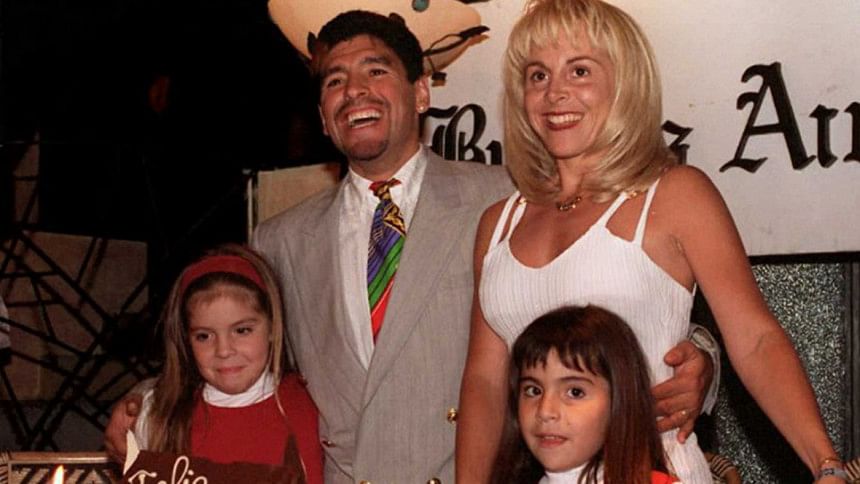
During the 15-month suspension which followed, Maradona tried his hand at coaching.
He was not successful. First at Deportivo Mandiyu, where he lasted two months, and later at the Racing Club, he proved that he was better at throwing parties and brawling.
By April 1995, his attempts at coaching were finished. In June 1995, the Boca Juniors offered him a two-and-a-half year contract.
Return to the Boca Juniors
Maradona attempted to make a comeback in October 1995, playing with Argentina's Boca Juniors against South Korea in the Olympic Stadium in Seoul.
Being older and slower, Maradona was easily out-performed by his team-mates, taking only one shot on goal.
Still, he retained his usual swagger with the press. "Personally I was satisfied with my game," he told Kate Battersby at the Sunday Telegraph (London).
"But we didn't play well as a team. My heart was full when I heard the national anthem.”
“And the crowd was good to me. Until these things die, I will keep playing football. I have made a lot of comebacks but I'm very happy with this one. It is good to play for Boca again."
Maradona had been persuaded to make his comeback by KBS television, in order to promote South Korea's bid for the 2002 World Cup games.
The television station offered him $1.75 million for televised interviews and public appearances.
Maradona embarrassed the South Koreans, however, by showing up late for scheduled appearances or missing them altogether.
He missed his plane and arrived late to a welcoming ceremony and news conference.
Maradona did not show up for a promised coaching session at an amusement park, leaving nearly 1,000 children and parents waiting for over two hours.
He failed to make an expected appearance at a Hyundai auto manufacturing plant.
The week following his South Korean trip, Maradona and the Boca Juniors scored a 1-0 victory against Colon de Santa Fe in Buenos Aires.
He was chosen by lottery to undergo another drug test following the game.
Maradona tested positive for cocaine, and was suspended a third time.
A Short-lived Comeback
Maradona returned to the field with the Boca Juniors in July 1997.
Boca played Racing Club in front of a near capacity crowd. A calf-muscle strain had the 36-year-old Maradona leaving the field twice during the game.
While a rigorous training program had left him in top physical shape, there were serious doubts about his overall health.
One doctor speculated that Maradona had sustained permanent brain damage from cocaine abuse.
On October 29, 1997, Maradona announced his retirement from the balcony of his home in Buenos Aires.
He claimed that powerful people were trying to frame him for drug use in order to make him leave the game.
He was quitting to protect himself and his family.
Argentine sports journalist Pablo Llonto told the international press that Maradona would have been left alone to play out his career had he not been so outspoken.
Indeed, he remained outspoken to the last, listing the names of the people he held responsible for encouraging the early end of his career.
Maradona made headlines in January 2000, when his cocaine addiction had caused heart problems.
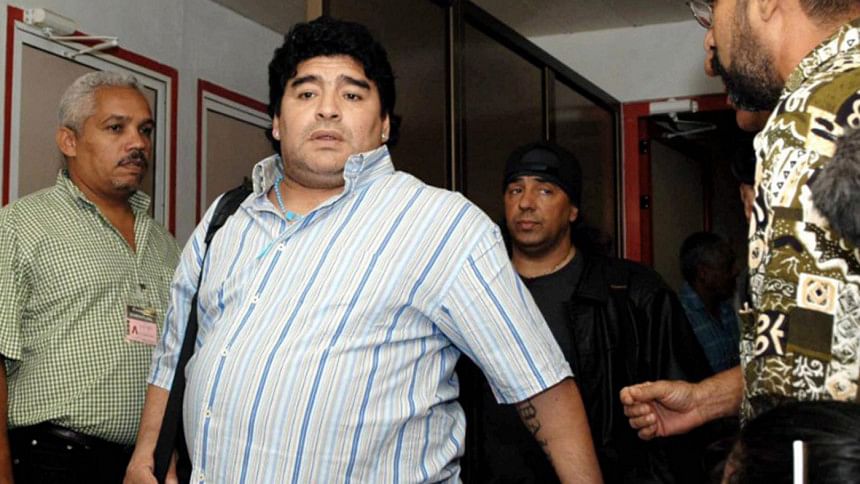
Police Chief Maximo Costa Rocha of the province of Maldonado confirmed reports that cocaine had been found in the former soccer champion's bloodstream, indicating excessive consumption.
The 39-year-old Maradona was transferred from Uruguay to Cuba on January 18 for treatment, including drug rehabilitation.
Honours for Diego
In 2000, he won FIFA Player of the Century award which was to be decided by votes on their official website, their official magazine and a grand jury.
Maradona won the Internet-based poll, garnering 53.6% of the votes against 18.53% for Pelé
Maradona has topped a number of fan polls, including a 2002 FIFA poll in which his second goal against England was chosen as the best goal ever scored in a World Cup; he also won the most votes in a poll to determine the All-Time Ultimate World Cup Team.
On 22 March 2010, Maradona was chosen number 1 in The Greatest 10 World Cup players of all time by the London-based newspaper The Times.

 For all latest news, follow The Daily Star's Google News channel.
For all latest news, follow The Daily Star's Google News channel. 



Comments